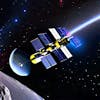June 13, 2023
S02E13: Discovering the Jellyfish Galaxy's Gas Trails and Other Space News with Steve and Hallie

Astronomy Daily with Steve Dunkley and his trusty AI Newsreader Hallie.
Ironically, space enthusiast Hallie dives into the extreme and violent conditions of Jellyfish galaxies, highlighting the unique gas trails and the goal of studying star...
Astronomy Daily with Steve Dunkley and his trusty AI Newsreader Hallie.
Ironically, space enthusiast Hallie dives into the extreme and violent conditions of Jellyfish galaxies, highlighting the unique gas trails and the goal of studying star formation, while the central conflict remains the influence of the main disk of a galaxy. In this episode, you will be able to: · Uncover the secrets of the Jellyfish galaxy and its intriguing gas trails that have captivated astronomers. · Dive into the NASA Earth Information Center, showcasing vital data on climate change and what it means for our world. · Get a glimpse of the Keck Cosmic Reionization Mapper's stunning debut image, bringing the Turtle Nebula to life. · Examine Space Force's partnership with SpaceX and ULA, and understand its significance for military space operations. · Delve into the cutting-edge concept of beaming solar power from space, and its potential to transform clean energy. The resources mentioned in this episode are: · Visit the Earth Information Center at NASA's headquarters in Washington, D.C. for an exhibit showcasing information about our environment and climate, including large videos and interactive media stories and narratives. · Check out the Keck Cosmic Reionization Mapper at the WM. Keck Observatory atop Mount Oka summit in Hawaii for detailed maps of gas around dying stars and other cosmic objects and to map the cosmic web that links and feeds galaxies. · Consider investing in space-based solar power technology, which could potentially yield eight times more power than solar panels on any location on the surface of the globe. Look into the California Institute of Technology's Space Solar Power Project, which aims to harvest solar power in space and transmit it to Earth. · Support Space Force by following their assignments for national security space launch missions divided equally between SpaceX and United Launch Alliance. These missions will help Space Force build out its communications and missile tracking satellite layers. · Keep an eye out for the Jellyfish galaxy J O 206, located around 700 million light years from Earth in the constellation of Aquarius the Water Bearer. This galaxy is a great example of a jellyfish galaxy with distinctive trails of gas that are ripped from it as it moves through the In The Jellyfish Galaxy The Jellyfish Galaxy, also known as J206, is a unique astronomical structure located around 700 million light years from Earth in the constellation of Aquarius. It is characterized by the trails of gas that are ripped from it as it makes its way through the material between galaxies. These gas trails create a stunning visual effect reminiscent of a jellyfish, hence the name. The Jellyfish Galaxy is a fascinating subject for astronomers, as it offers a chance to study the behavior of stars and other celestial bodies in an environment vastly different from our own galaxy. Throughout the podcast, host Steve Dunkley and guest Hallie delved into the fascinating world of the Jellyfish Galaxy, providing a wealth of knowledge and insights. They discussed the unique gas trails that characterize this type of galaxy and the stunning images captured by the Hubble Space Telescope. Hallie also shared how studying the Jellyfish Galaxy can give astronomers a better understanding of star formation in extreme conditions, far from the influence of a galaxy's main disk. NASA's Earth Information Center NASA's Earth Information Center is a cutting-edge exhibit designed to merge science and visualizations, offering visitors an immersive experience that deepens their understanding of our planet's changing climate. The center, which showcases data and insights provided by NASA's Earth-monitoring satellites and instruments, supports the wider Biden-Harris administration's emphasis on addressing climate change. By providing accessible information about the environment and climate, the exhibit helps bridge the gap between scientific research and everyday understanding. Steve and Hallie explored the role of NASA's Earth Information Center in raising awareness about climate change and its effects on our planet. Hallie emphasized the importance of making complex data accessible to laypersons, especially when it comes to helping communities understand and respond to the challenges posed by climate change. The podcast provided valuable context for why such initiatives are critical in educating the public on the importance of environmental conservation and stewardship. The Turtle Nebula The Turtle Nebula, a celestial structure comprised of a dying star surrounded by a glowing envelope of gas, was recently captured by the Keck Cosmic Reionization Mapper (KCRM) at the WM Keck Observatory in Hawaii. This milestone event, known as the first light, signifies the telescope's readiness to begin its mission. The KCRM is designed to map the cosmic web that links and feeds galaxies – an essential part of understanding the large-scale structure of the universe. Steve and Hallie discussed the first light image of the Turtle Nebula and the significance of this celestial object in the study of the cosmic web. Hallie explained that the Turtle Nebula offers astronomers valuable information about the dynamic nature of the universe and its interconnected components. The conversation highlighted the importance of observing celestial structures like the Turtle Nebula to advance our understanding of the universe and its constituent elements.
For more Astronomy Daily visit www.spacenuts.io
Ironically, space enthusiast Hallie dives into the extreme and violent conditions of Jellyfish galaxies, highlighting the unique gas trails and the goal of studying star formation, while the central conflict remains the influence of the main disk of a galaxy. In this episode, you will be able to: · Uncover the secrets of the Jellyfish galaxy and its intriguing gas trails that have captivated astronomers. · Dive into the NASA Earth Information Center, showcasing vital data on climate change and what it means for our world. · Get a glimpse of the Keck Cosmic Reionization Mapper's stunning debut image, bringing the Turtle Nebula to life. · Examine Space Force's partnership with SpaceX and ULA, and understand its significance for military space operations. · Delve into the cutting-edge concept of beaming solar power from space, and its potential to transform clean energy. The resources mentioned in this episode are: · Visit the Earth Information Center at NASA's headquarters in Washington, D.C. for an exhibit showcasing information about our environment and climate, including large videos and interactive media stories and narratives. · Check out the Keck Cosmic Reionization Mapper at the WM. Keck Observatory atop Mount Oka summit in Hawaii for detailed maps of gas around dying stars and other cosmic objects and to map the cosmic web that links and feeds galaxies. · Consider investing in space-based solar power technology, which could potentially yield eight times more power than solar panels on any location on the surface of the globe. Look into the California Institute of Technology's Space Solar Power Project, which aims to harvest solar power in space and transmit it to Earth. · Support Space Force by following their assignments for national security space launch missions divided equally between SpaceX and United Launch Alliance. These missions will help Space Force build out its communications and missile tracking satellite layers. · Keep an eye out for the Jellyfish galaxy J O 206, located around 700 million light years from Earth in the constellation of Aquarius the Water Bearer. This galaxy is a great example of a jellyfish galaxy with distinctive trails of gas that are ripped from it as it moves through the In The Jellyfish Galaxy The Jellyfish Galaxy, also known as J206, is a unique astronomical structure located around 700 million light years from Earth in the constellation of Aquarius. It is characterized by the trails of gas that are ripped from it as it makes its way through the material between galaxies. These gas trails create a stunning visual effect reminiscent of a jellyfish, hence the name. The Jellyfish Galaxy is a fascinating subject for astronomers, as it offers a chance to study the behavior of stars and other celestial bodies in an environment vastly different from our own galaxy. Throughout the podcast, host Steve Dunkley and guest Hallie delved into the fascinating world of the Jellyfish Galaxy, providing a wealth of knowledge and insights. They discussed the unique gas trails that characterize this type of galaxy and the stunning images captured by the Hubble Space Telescope. Hallie also shared how studying the Jellyfish Galaxy can give astronomers a better understanding of star formation in extreme conditions, far from the influence of a galaxy's main disk. NASA's Earth Information Center NASA's Earth Information Center is a cutting-edge exhibit designed to merge science and visualizations, offering visitors an immersive experience that deepens their understanding of our planet's changing climate. The center, which showcases data and insights provided by NASA's Earth-monitoring satellites and instruments, supports the wider Biden-Harris administration's emphasis on addressing climate change. By providing accessible information about the environment and climate, the exhibit helps bridge the gap between scientific research and everyday understanding. Steve and Hallie explored the role of NASA's Earth Information Center in raising awareness about climate change and its effects on our planet. Hallie emphasized the importance of making complex data accessible to laypersons, especially when it comes to helping communities understand and respond to the challenges posed by climate change. The podcast provided valuable context for why such initiatives are critical in educating the public on the importance of environmental conservation and stewardship. The Turtle Nebula The Turtle Nebula, a celestial structure comprised of a dying star surrounded by a glowing envelope of gas, was recently captured by the Keck Cosmic Reionization Mapper (KCRM) at the WM Keck Observatory in Hawaii. This milestone event, known as the first light, signifies the telescope's readiness to begin its mission. The KCRM is designed to map the cosmic web that links and feeds galaxies – an essential part of understanding the large-scale structure of the universe. Steve and Hallie discussed the first light image of the Turtle Nebula and the significance of this celestial object in the study of the cosmic web. Hallie explained that the Turtle Nebula offers astronomers valuable information about the dynamic nature of the universe and its interconnected components. The conversation highlighted the importance of observing celestial structures like the Turtle Nebula to advance our understanding of the universe and its constituent elements.
For more Astronomy Daily visit www.spacenuts.io
New to Astronomy Daily - The Podcast?
Here are some great episodes to start with.













